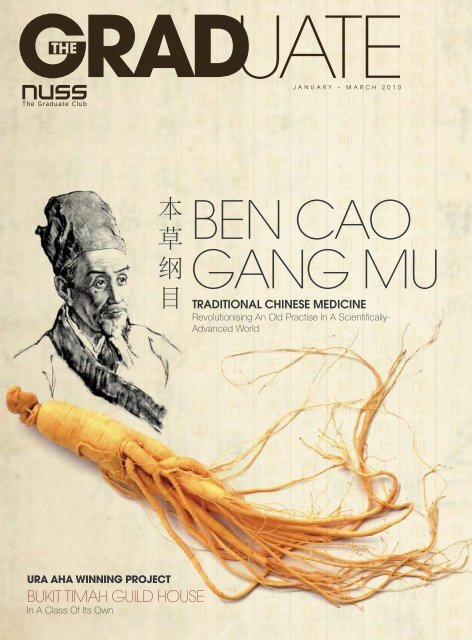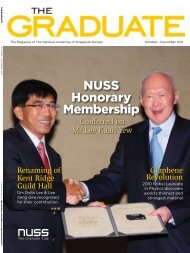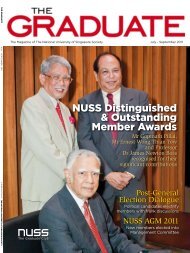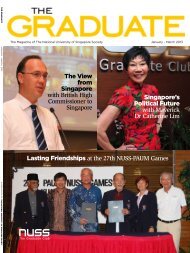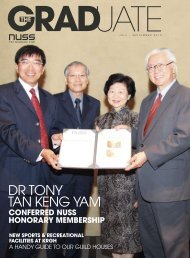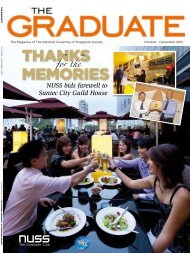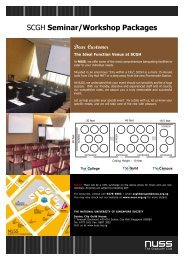Ben Cao GanG Mu - NUSS
Ben Cao GanG Mu - NUSS
Ben Cao GanG Mu - NUSS
You also want an ePaper? Increase the reach of your titles
YUMPU automatically turns print PDFs into web optimized ePapers that Google loves.
pResIdent’s MessAge<br />
Dear Fellow Members,<br />
Season’s greetings!<br />
I hope you had a good time<br />
over the festive holidays and<br />
are looking forward to the<br />
New Year.<br />
The last quarter of 2009 has<br />
been eventful for <strong>NUSS</strong>.<br />
We continued to build<br />
upon Intellectual Pursuit<br />
initiatives. In October, Professor Tan Eng Chye, NUS provost<br />
and Deputy President (Academic Affairs), shared with our<br />
members on the challenges faced by NUS, and how the<br />
education at the University has evolved over the years. In<br />
November, we had the privilege of hosting His Excellency,<br />
Dato’ Md Hussin Nayan, High Commissioner of Malaysia to<br />
Singapore, as part of the Meet-The-Ambassador Series. The<br />
session with His Excellency was enlightening, as the topics<br />
centred upon issues faced by both Singapore and Malaysia.<br />
If you missed out on these dialogues, you will be pleased to<br />
know that there will be an upcoming dialogue with Dr Ng Eng<br />
Hen, Minister for Education and Second Minister for Defence<br />
on 22 January. In this session, Dr Ng will discuss the future of<br />
Singapore’s education. I am sure many of us will be keen to<br />
hear him speak.<br />
We had two significant sporting events in the last quarter. In<br />
October, we saw the finale of the ITIS-<strong>NUSS</strong> Games held at<br />
Singapore Polytechnic. This bi-annual event involves <strong>NUSS</strong>,<br />
NUS, NTU and other tertiary organisations in Singapore.<br />
In the same month, we hosted the 24th <strong>NUSS</strong>-PAUM<br />
games where our sporting members and Persatuan Alumni<br />
University of Malaya (PAUM) competed in seven different<br />
sporting events. Even though PAUM emerged the overall<br />
champion, the games were a great way to maintain the close<br />
ties between the Society and PAUM.<br />
On 5 November, we organised a special dinner with <strong>NUSS</strong><br />
members who were recipients of the National Day Award<br />
2009, to acknowledge their contributions to the nation.<br />
I am also pleased to announce the creation of two special<br />
<strong>NUSS</strong> awards, the Distinguished Member Award and the<br />
Outstanding Member Award, to recognise members who<br />
have contributed to <strong>NUSS</strong> as well as the society at large.<br />
The judging panel will be chaired by Mr Gerard Ee, <strong>NUSS</strong><br />
Advisory Panel Member and I look forward to receiving your<br />
nominations of fellow members for these awards.<br />
We constantly try to reach out to the wider graduate<br />
community outside of <strong>NUSS</strong>. Through initiatives by the<br />
iConnect Sub-Committee and www.nuss.meetingplace.<br />
com.sg, we hope to engage this segment through relevant<br />
and interesting programs and events. At the last networking<br />
event themed ‘Prime for the Upturn’, held at Union Bar on 24<br />
November, the feedback and turnout was very promising, and<br />
we hope to organise more of such functions in the near future.<br />
It is also our desire to support worthy causes. The Sails<br />
for Smiles fundraising dinner event on 13 November was<br />
organised in support of two NUS medical students, Jiang<br />
Lei and Yee Onn participating in the Clipper Round the<br />
World Yacht Race 09-10. Dr Vivian Balakrishnan, Minister<br />
of Community Development, Youth and Sports honoured<br />
us with his presence as Guest-of-Honour. An auction on<br />
the same evening also saw over $12,000 raised for Club<br />
Rainbow. We are touched by the sailors’ bravery in testing<br />
themselves against the elements and their passion to do<br />
good for the underprivileged. I certainly hope this will motivate<br />
many others to step forward and contribute to society. More<br />
details of the event are available on page 13 of this issue of<br />
The Graduate.<br />
We also met with <strong>NUSS</strong>U leaders to strengthen bonds<br />
with our future potential <strong>NUSS</strong> leaders. At the meeting, we<br />
announced the signing of an agreement with the National<br />
Youth Council (NYC) to start the NYC-<strong>NUSS</strong>: Singapore<br />
2010-ChangeMakers Grant. Funded by NYC and SYOGOC,<br />
this grant will allow both NUS undergraduates and <strong>NUSS</strong><br />
members under the age of 35 to apply for a subsidy of up to<br />
$4,000 for community activities that promote and celebrate<br />
the upcoming Youth Olympic Games. We believe this initiative<br />
will not only enable us to reach out to younger graduates and<br />
undergraduates, but also encourage further activities centred<br />
on Singapore’s biggest sporting event in 2010. Further details<br />
of the grant are also available on page 16 of this issue.<br />
Looking ahead to 2010, I wish to update you that difficult site<br />
conditions have resulted in a slight delay to the completion of<br />
Phase 2 of the KRGH Re-development. However the project<br />
committee has been working very hard to ensure that we<br />
obtain our TOP within the first quarter of 2010.<br />
The year ahead is filled with much hope and many<br />
opportunities for us to strive for ever greater achievements.<br />
Just like a family, we seek your support to stay connected with<br />
us. Let <strong>NUSS</strong> continue to be your ‘home away from home’.<br />
I wish everyone a Happy 2010 ahead and all our Chinese<br />
members a prosperous Lunar New Year!<br />
Johnny Tan<br />
President<br />
0
The Graduate is the quarterly publication of<br />
The National University of Singapore Society (<strong>NUSS</strong>)<br />
Kent RIdge gUIld hOUSe<br />
9 Kent Ridge Drive<br />
Singapore 119241<br />
T : 6779 1811 F : 6778 8095<br />
Email : secretariat@nuss.org.sg<br />
SUnteC CIty gUIld hOUSe<br />
3 Temasek Boulevard<br />
#05-001 Suntec City Mall<br />
Singapore 038983<br />
T : 6779 1811 F : 6887 3802<br />
bUKIt tImAh gUIld hOUSe<br />
1F Cluny Road<br />
Singapore 259602<br />
T : 6779 1811 F : 6469 6019<br />
AdAm PARK gUIld hOUSe<br />
7 Adam Park<br />
Singapore 289926<br />
T : 6463 4528 F : 6463 4529<br />
edItORIAl<br />
Managing Editors : Audrey Chong<br />
Art Director : Rendy Aryanto<br />
Designer : Genz Lim<br />
Contributing Writers : Andri Tanubrata<br />
Christine Chong<br />
Joan Chew<br />
Travis Teo<br />
Li m Say Liang<br />
Vivien Khoo<br />
For editorial contribution,<br />
Email : thegraduate@nuss.org.sg<br />
mARKetIng & OPeRAtIOnS<br />
Advertising Sales : Diana Teo<br />
Photographers : Clarissa Dias Cavalheiro<br />
Enrico Tanubrata<br />
Rendy Aryanto<br />
Sandra Darwis<br />
For advertising enquiries,<br />
Email : diana@lancer.com.sg<br />
The Graduate is produced for <strong>NUSS</strong> by<br />
9B Keong Saik Road<br />
Singapore 089117<br />
T : 6324 3466 F : 6324 3477<br />
All rights reserved. Copyright 2009<br />
Reproduction in whole or part of the magazine is strictly prohibited without the<br />
expressed permission of the publisher. the views of the contributors are entirely<br />
their own and do not necessarily represent those of nUSS, the management<br />
Committee and lancer design. nUSS does not endorse all products and services<br />
featured in the magazine’s advertisements, except for its own advertisement(s).<br />
Printed in Singapore by fabulous Printers Pte ltd<br />
mICA (P) 152/03/2009<br />
nUSS AdVISORy PAnel<br />
Gerard Ee, Professor Tommy Koh, Professor Arthur Lim, Wong Ah Long<br />
nUSS mAnAgement COmmIttee 2009/2010<br />
OFFICE BEARERS<br />
President : Johnny Tan Khoon Hui<br />
Vice President : Chong Hoong Sang<br />
honorary secretary : Lai Kim Seng<br />
honorary Treasurer : Siva S Retnam<br />
honorary assistant secretary : Edward S Tay<br />
honorary assistant Treasurer : Wong Peng Meng<br />
COMMITTEE MEMBERS<br />
Mohan Balagopal Joshua VM Kuma (Dr) Ong Pin Sam<br />
Vincent Rasa <strong>Ben</strong>edict Lau Kwong Chung Toh Yong Soon<br />
Fong Poh Him (Dr) Keith Alan Liew (Dr) Yip Kum Fei<br />
Rosemary Khoo (Dr) Chandra Mohan K Nair<br />
SUB-COMMITTEE CHAIRPERSONS<br />
alumni development & University relations : Chandra Mohan K Nair<br />
Community Care : Ong Pin Sam<br />
Cultural : Fong Poh Him (Dr)<br />
disciplinary : Chandra Mohan K Nair<br />
Finance : Siva S Retnam<br />
house, Food & Beverage : Chong Hoong Sang<br />
iConnect : Yip Kum Fei<br />
intellectual Pursuit : Joshua VM Kuma (Dr)<br />
Membership : Edward S Tay<br />
s-Connect : Rosemary Khoo (Dr)<br />
sports and recreation : Vincent Rasa <strong>Ben</strong>edict<br />
SPECIAL PROJECTS/TASKS<br />
alumni Complex/KrGh : Lai Kim Seng<br />
BTGh official opening : Chong Hoong Sang<br />
BTGh Project : Lau Kwong Chung<br />
Constitution & regulations : Mohan Balagopal<br />
editorial/Communications : Lai Kim Seng<br />
SOCIETY’S REPRESENTATIVE<br />
alumni international singapore (ais) : Mohan Balagopal<br />
reaCh (Feedback Unit) : Joshua VM Kuma (Dr)<br />
People’s association : Toh Yong Soon<br />
SeCRetARIAt mAnAgement teAm<br />
Chief executive officer<br />
Chao Ye Peng<br />
Finance director<br />
ceo@nuss.org.sg 6586 3700<br />
Ong Cheng Lee (Ms)<br />
operations director<br />
chenglee@nuss.org.sg 6586 3702<br />
Sasidharan Pillai<br />
Membership director<br />
sasi@nuss.org.sg 6586 3755<br />
Jenny Ng (Ms) jennyng@nuss.org.sg 6586 3718<br />
Corporate affairs & new Media director<br />
Tong Hsien-Hui hsienhui@nuss.org.sg 6586 3735<br />
head, Corporate & Membership Communications<br />
Almeta Chia (Ms) almeta@nuss.org.sg 6586 3766<br />
information systems Manager<br />
Ho Weng Wah<br />
hr & Training Manager<br />
wengwah@nuss.org.sg 6586 3711<br />
George Chua georgechua@nuss.org.sg 6586 3758<br />
sports & events Manager<br />
Richard Chitrakar richardc@nuss.org.sg 6586 3712<br />
sCGh Club operations Manager<br />
Desmond Lim<br />
Purchasing Manager<br />
desmondlim@nuss.org.sg 6578 9827<br />
Vincent Ng<br />
Maintenance Manager<br />
vincentng@nuss.org.sg 6586 3742<br />
Mike Chan mikechan@nuss.org.sg 6586 3738
projeCT<br />
updaTe<br />
0<br />
re-deVeloPMenT oF<br />
kent RIdge gUIld<br />
HoUse pHAse 2<br />
The Gym – interior fitting works in progress<br />
External View of New Sports Hall<br />
View of New Squash Court<br />
We crossed a significant milestone in December 2009 with<br />
the completion of the superstructure for Phase 2 of the<br />
KRGH Re-development project.<br />
In the following weeks, good weather permitting, we hope to<br />
see good progress on the remaining items of work involving<br />
internal M&E services, interior design and architectural<br />
finishes as well as external works and other related<br />
supporting services.<br />
The current temporary Secretariat office will shift to the<br />
office in the new building sometime in mid Jan 2010. We<br />
target to receive the Temporary Occupation Permit (TOP) for<br />
the entire project by the end of 1 st quarter 2010.<br />
New Secretariat Office
ura aha Winning projeCT<br />
bUkIt tIMAH gUIld HoUse<br />
1F Cluny Road<br />
Class of its own<br />
2009 Awards<br />
Category A<br />
Built in the late 1920s, this two-storey Art Deco bungalow,<br />
once used to house the teaching staff of the former Raffles<br />
College, has been meticulously cajoled back to life and<br />
transformed into a classy sanctuary, the Bukit Timah Guild<br />
House, that cultivates camaraderie.<br />
Firm Foundations<br />
One of the four identical bungalows in the area, this<br />
bungalow has aged gracefully. Except for strengthening<br />
works on the upper storey timber floor slab, it was structurally<br />
sound, giving the project team a good foundation to perform<br />
a marvellous revival of tropically-inspired architectural and<br />
design concepts.<br />
Crowning Glory<br />
The original clay-tile roof was duly repaired. A false ceiling<br />
that had been previously added was removed to uncover<br />
the original timber ceiling joists, a smart move that recovered<br />
much of the original charm and character of the house. To rid<br />
the old house of its water seepage problems, a secondary<br />
roof was discretely incorporated right under the main roof<br />
without affecting its original character.<br />
Owner: National University of Singapore Society<br />
Architect: RichardHO Architects<br />
Engineer: JS Tan & Associates<br />
Contractor: U.SAGE Contracts Pte Ltd<br />
Photography by Raymond Toh, courtesy of RichardHO Architects<br />
The contents of this article is by courtesy of The Urban Redevelopment Authority<br />
A Nostalgic Air<br />
The team did an outstanding job in reviving the tropical<br />
appeal of the house, bringing back the natural ventilation<br />
that once flowed through the very same doors. Open<br />
verandahs with exposed roof eave rafters and timber doors<br />
lining the outer corridors at the rear of the house were<br />
carefully recovered and reinstated. The door leaves were<br />
painstakingly recreated to fine detail in the pattern of the<br />
original leaves based on remnants uncovered. All of the<br />
original timber staircase and balustrades were also retained<br />
and lovingly restored.<br />
The new alfresco terrace added atop the original flat-top<br />
portico further enhanced the charm of the house. It gives the<br />
bungalow a new niche that takes full advantage of its tropical<br />
setting, reinventing its appeal for modern guests who love a<br />
little tête-à-tête under the stars.<br />
Overall, the team has successfully brought to light the old<br />
house’s many rare and inherent features, and ensuring the<br />
new elements added suit its present day purpose as an<br />
elegant and exclusive alumni clubhouse.<br />
projeCT<br />
updaTe<br />
0
inside<br />
sTory<br />
0<br />
Shifting PercePtionS:<br />
tRAdItIonAl<br />
cHInese MedIcIne<br />
if you have Made a Trip To Tan ToCk<br />
seng or singapore general hospiTal<br />
reCenTly, you MighT have CoMe<br />
aCross a speCialised TradiTional<br />
Chinese MediCine (TCM) uniT. WhaT<br />
Was onCe seen as an unorThodox<br />
TreaTMenT MeThod is noW Widely<br />
aCCepTed and reCognised by boTh The<br />
Masses and The insTiTuTions. WhaT has<br />
Caused This Change in perCepTions?<br />
AUdReY cHong and tRAVIs teo<br />
unravels The reasons behind The rise<br />
of TCM.<br />
The Beginnings<br />
In modern-day Singapore, most people would have at some<br />
point or another taken TCM. This could be in the form of<br />
‘Essence of Chicken’, ginseng tea or chrysanthemum tea.<br />
However, few people would have known the roots of TCM or<br />
what TCM constitutes.<br />
In truth, the exact origins of TCM is vague as much of its<br />
development occurred before written history. Human activity<br />
in China began over 1.7 million years ago. The use of plants<br />
as medicine can be dated back to the origin of mankind.<br />
When man experimented with new plants in search of food,<br />
he also discovered the effects they had on the human body.<br />
Similarly, the exact origin of moxibustion and acupuncture<br />
are unknown, but it is believed when the ancient Chinese lit<br />
fires to warm themselves that they found that heated stones
and sand wrapped in animal skin or bark could reduce pain.<br />
In turn, this led to the discovery of moxibustion treatment<br />
methods. As for acupuncture, it was deduced that it was<br />
discovered in their process of using stone instruments.<br />
Whether these theories are accurate, it is quite certain that<br />
the use of medical tools dates back well into the Stone Age.<br />
This is because, when written history began, much has<br />
already been known about Chinese Medicine. The advanced<br />
knowledge that were recorded in the first medical books<br />
suggests that there was a great deal of medical development<br />
before 2500 BC. Particularly, in one entry, it was noted that<br />
Hua Tuo was using herbal anesthesia to conduct surgery in<br />
the second century AD.<br />
However, it was Li Shizhen (AD 1517-1593) who brought<br />
about the continued advent of TCM into the modern era.<br />
By writing <strong>Ben</strong> <strong>Cao</strong> Gang <strong>Mu</strong>, ‘the General Outlines and<br />
Divisions of Herbal Medicine’, he made it possible for people<br />
to track the past knowledge and cumulatively increased the<br />
wealth of knowledge in the area. Today, records of medicinal<br />
substances have grown threefold from 1,900 to nearly 6,000.<br />
An Overview – TCM Practices<br />
Tracing its roots from China thousands of years ago, it is<br />
natural that TCM is most established in the East Asian cities<br />
with heavy Chinese influences, such as Hong Kong, Taiwan,<br />
and Singapore.<br />
Since then, TCM practices have evolved substantially.<br />
Today, TCM is more than just Chinese herbal medicine<br />
(Zhong Yao), moxibustion (Jiu) and acupuncture (Zhen Jiu), it<br />
includes dietary therapy and Shiatsu massage. Its combined<br />
therapeutic effects with Qigong and Taiji are also very much<br />
drawn upon from time to time.<br />
Basis of Theory<br />
In theory, TCM is a method of healing and strengthening the<br />
body. It is rooted in the observation of nature, the cosmos<br />
and the human body. Underlying these are the major theories<br />
Yin Yang, the ‘Five Phases’, the human body ‘Channel<br />
system’, ‘Organ theory’ (Zang Fu), ‘Six Confirmations’ and<br />
‘Four Layers’.<br />
While these theories are derived very differently on varying<br />
grounds, the foundation principles of TCM are largely based<br />
on the concept that the human body is a whole universe<br />
in seeking balance. This universe consists of various<br />
interconnected systems that are constantly working to strike<br />
equilibrium in the body.<br />
Differences between TCM and Western Medicine<br />
The TCM approach is fundamentally different from that of<br />
Western Medicine. In TCM, the understanding of the human<br />
body is based on the holistic understanding of the universe<br />
as described in Taoism; medical treatment is based primarily<br />
on the diagnosis and differentiation of syndromes.<br />
inside<br />
sTory<br />
0
inside<br />
sTory<br />
0<br />
Another way of looking at the difference between Western<br />
Medicine and TCM is the direction magnification takes. With<br />
Western Medicine, technology is used to isolate the smallest<br />
possible particle that may be diseased – all the way down to<br />
the electrical charge of a molecule. For Chinese Medicine,<br />
through the eyes of the ‘human organism’, the big picture<br />
is perceived to be of a greater importance, not the electrical<br />
charge of a particular molecule or a cell with a leaky wall.<br />
Treatment and Diagnostic Techniques<br />
In TCM, prescriptions are usually focused on the individual,<br />
centred on the principle that every person is unique in our<br />
physical make-up. The prescription of herbal medicine is<br />
usually preceded by a diagnosis that observe symptoms. It is<br />
comprised of four methods – observe, hear, smell, touch and<br />
ask (medical history).<br />
These techniques are frequently used in conjunction with<br />
pulse-reading by TCM practitioners to comprehend the<br />
ailment and symptoms suffered by the patients. In some<br />
instances, this has led to the overall criticism that TCM is<br />
mainly based on treatments for counteracting the symptoms,<br />
without largely understanding the cause of the ailments. As a<br />
result, this hindered the acceptance of TCM in most Western<br />
societies, where understanding and distilling the science of<br />
diseases and ailments is key.<br />
The Comeback of TCM<br />
TCM however, is growing in popularity in some contemporary<br />
societies like Singapore. The main reason being, next<br />
to Western Medicine, it is increasingly considered as an<br />
‘alternative’, or ‘complementary’ treatment by a growing<br />
number of patients turning to TCM when Western Medicine<br />
fails to treat or relieve chronic disorders.<br />
This is especially so in the turning to acupuncture in relieving<br />
chronic pain such as backache or migraines.<br />
According to a My Paper report on 2 July 2009, Terrence Ng,<br />
an engineering manager, relied less on his doctor after taking<br />
TCM classes at the Singapore College of Traditional Chinese<br />
Medicine and noticing a marked improvement in health.<br />
This ties in with the theory that TCM is both a form of healing<br />
and also a treatment that works to strengthen the body. The<br />
rise in the number of practitioners can also be attributed<br />
to a cultural backlash where the younger generations<br />
are progressively seeking to embrace their roots with the<br />
modernisation of society.<br />
The number of applicants for courses at the Singapore<br />
College of TCM has jumped from 120 in 2008 to 200 in<br />
2009. The increase in the applicants, particularly of those not<br />
already in the industry, also accords a growing trust in the<br />
effectiveness of TCM in Singapore.<br />
TCM – Is It Really Effective?<br />
The effectiveness of TCM has always been a subject of<br />
contention. While traditionalists advocate TCM’s efficiency<br />
as an effective treatment method for various ailments,<br />
scientists claim there is no basis to the purported relieves<br />
that TCM can bring.
Indeed, where herbal medication is concerned, there<br />
are numerous factors which affects the effectiveness<br />
of the medicine. For one, the authenticity of the herb’s<br />
signature impacts the effectiveness of the treatment. Other<br />
environmental factors that the herbs are subjected to during<br />
its growth might also potentially have negative or reinforcing<br />
impact on its overall effectiveness. Despite the criticism,<br />
research in the area is not advancing sufficiently to ward<br />
off detractors because of the high costs and specialised<br />
expertise required.<br />
Of course, herbal medicine is not totally without its<br />
contribution to the medical industry. For instance, the<br />
Chinese Wormwood is now used globally to treat malaria<br />
and Chinese Ephedra has been attributed to the discovery of<br />
treatments for asthma and Hay Fever.<br />
Contrary to herbal medicines, acupuncture drew much<br />
research interest. One area where acupuncture is deemed<br />
to be convincingly effective is in the treatment of nausea<br />
and seasickness. Increasingly, there are seasick armbands<br />
available in the market that works by essentially pressing<br />
on an acupuncture point on the wrist. Scientific and<br />
anecdotal evidence have shown that this is effective in<br />
preventing nausea.<br />
A 2008 study also suggested that combining<br />
acupuncture with conventional infertility treatments<br />
such as IVF greatly improves the success rates of<br />
such medical interventions. In a recent report, The<br />
World Health Organisation has also issued favourable<br />
observations on acupuncture in the areas of “adult<br />
postoperative and chemotherapy nausea and vomiting<br />
and in postoperative dental pain”.<br />
Beyond these, however, the rest of the research results<br />
are more often than not controversial. In Edzard Ernst’s<br />
words, Professor of Complementary Medicine in the<br />
United Kingdom, “research in the area is growing<br />
but emerging clinical evidence seems to imply that<br />
acupuncture is effective for some but not all conditions.”<br />
Most chronic ailments, for example, such as back-pain,<br />
neck-pain and headache, have conflicting anecdotal<br />
evidence with acupuncture.<br />
Given the ongoing debate surrounding TCM and its<br />
continued rise in popularity, medical practitioners are<br />
cautious in using TCM as the sole treatment method.<br />
Rather, TCM is often recommended as a means to<br />
strengthen health and as a complementary form of<br />
medicine to conventional treatment.<br />
TCM – Is it Safe?<br />
Even then, patients who are contemplating to seek TCM<br />
as a treatment to should be wary of some of the potential<br />
safety issues.<br />
inside<br />
sTory<br />
0
inside<br />
sTory<br />
0<br />
Practitioner is Key<br />
Undeniably, the practitioner plays a pivotal role in ensuring<br />
that the ailment is diagnosed correctly and that the treatment<br />
endorsed is appropriate. At this juncture, although TCM<br />
training courses are aplenty in China, few of them are<br />
accredited. To complicate matters, the training duration of the<br />
practitioners vary from months to years.<br />
The Risk of Allergy<br />
As TCM usually involves the consumption of herbal medicine,<br />
that are made up of a concoction of different elements within<br />
the herb, it is hard for patients to ascertain the exact harm<br />
that might result. In some mild instances, the patient would<br />
experience allergy; in some severe cases, this could mean<br />
poisoning. This necessitates consultation with a trained<br />
person prior to dispensing medication.<br />
Lack of Standardisation<br />
Chinese herbal medication are often not standardised from<br />
one pill to the next, or from one brand to the next, and<br />
can be reformulated, remixed, or altered by any company.<br />
Essentially, this means the same dosage for one brand may<br />
be heavier compared to the other. Consequently, it makes<br />
the effectiveness of Chinese medication unpredictable.<br />
Regulating TCM<br />
Due to nagging safety issues and incidents of herb abuse,<br />
governments and health organisations are recognising<br />
the need to regulate the industry. The Traditional Chinese<br />
Medicine Practitioners Act passed on 14 November 2000<br />
provides such a form of regulation for the industry.<br />
The Act stated that practitioners of TCM must register with<br />
the TCM Practitioners Board, and with effect from 2004,<br />
registered practitioners must also possess valid practising<br />
certificates. (For a listing of registered TCM practitioners, visit<br />
www.tcmpb.gov.sg)<br />
Along with recognition and the installation of proper<br />
accreditation guidelines, the stature accorded to TCM<br />
industry and the practitioners are now elevated. Having<br />
a governing body and an accredited degree programme<br />
ensure that the practitioners will have a uniform standard of<br />
practice. Implicitly, this provides a platform for faster growth<br />
and maturity of the industry.<br />
That said, while regulations and accreditation provide the<br />
launchpad, it is really the research discoveries and equipping<br />
practitioners with the appropriate knowledge that will propel<br />
the industry forward.<br />
Currently, TCM training is provided at three different colleges<br />
in Singapore, the Singapore College of Traditional Chinese<br />
Medicine, Institute of Chinese Medical Studies and the<br />
Nanyang Technological University (NTU).<br />
Although the degree offered in NTU is not a specialised<br />
one, but a double degree in Bachelor of Science (Hons) in<br />
Biomedical Sciences and Medicine (Chinese Medicine), it is<br />
momentous to have a government affiliated university, offer a<br />
TCM-related course. This signifies the acceptance of TCM.<br />
With Singapore poised to be a biomedical hub and medical<br />
tourism hotspot, the prospects of moving the industry one<br />
step closer to being a reliable source of treatment worldwide<br />
is slowly but surely manifesting.<br />
Shifting Perceptions<br />
This one small step is part of a paradigm shift of perceptions<br />
in the medical industry. The Westernised world used to be<br />
bounded by the limitations of technological advancements<br />
and the speed of laboratory discoveries – a signature of<br />
Western medicine. With the growing acceptance of TCM as<br />
a legitimate treatment method, a rich plethora of possibilities<br />
have been unearthed.<br />
In its infancy, Singapore’s medical industry is looking at TCM<br />
as complementary treatment. Judging from Hong Kong and<br />
Taiwan’s medical industry, which are ahead of Singapore in its<br />
adoption of TCM treatments, TCM is set to be fully integrated<br />
with Western Medicine in the very near future.<br />
Certainly, the future seems to be bright for TCM practitioners<br />
as it evolves to encompass a more research-grounded<br />
industry. Perhaps soon, a new reference will be coined in<br />
place of ‘Traditional Chinese Medicine’ to better represent it.
UPClose:<br />
dR koH HWee lIng<br />
in relaTion To The TheMe For<br />
This issUe oF The GradUaTe,<br />
AUdReY cHong GeTs a PeeK<br />
inTo The world oF herBal<br />
MediCine By CaTChinG UP<br />
wiTh dr Koh hwee linG,<br />
assoCiaTe ProFessor FroM<br />
The naTional UniVersiTy oF<br />
sinGaPore, deParTMenT oF<br />
PharMaCy.<br />
Dr Koh harvesting Panax notoginseng roots on her field trip in Yunnan (China)<br />
TCM – A Natural Inclination<br />
For a veteran who has been researching on herbs for more<br />
than 12 years, passion is certainly still running high. Dr Koh<br />
shared, “It was a natural decision for me to want to find out<br />
more about herbs especially since I grew up taking them.”<br />
A Bigger Mission<br />
What started off as a means to quell<br />
her curiosity on the subject matter<br />
has now taken on a different spin<br />
as she has a bigger mission. That<br />
is, to address the controversies<br />
surrounding the subject matter<br />
– efficacy, quality and safety issues.<br />
According to her, these three<br />
issues will always be close to<br />
the hearts of many healthcare<br />
professionals and patients alike<br />
when they are considering to adopt<br />
TCM as complementary treatment.<br />
Realising a Holistic Treatment Model<br />
Asked what she sees TCM’s role in the future, Dr Koh<br />
explains that in Singapore, Western Medicine is still the<br />
primary form of healthcare despite the popularity of TCM.<br />
However, she predicts that integrative treatment methods<br />
“I would always encourage<br />
my students by telling them<br />
that research work cannot<br />
stop because we must<br />
continue to find a better cure<br />
and to improve the quality<br />
and safety of complementary<br />
medicine in order to harness<br />
the potential benefits.”<br />
– a patient would be diagnosed and prescribed with both<br />
Western and TCM medication by qualified practitioners<br />
– would gradually gain popularity in the future. To<br />
educate students (our future healthcare professionals and<br />
consumers) in TCM and herbal medicine, Dr Koh runs a<br />
course on Complementary and Alternative Medicine for<br />
about 400 students. A little medicinal<br />
plant garden has also been set up on<br />
campus for teaching and research<br />
purposes. She has also published a<br />
book entitled “A Guide to Medicinal<br />
Plants: an illustrated, scientific and<br />
medicinal approach”.<br />
An Uphill Task<br />
The journey ahead is long and winding.<br />
Beset by the inadequate research<br />
this area has, as well as the previous<br />
occasional bad press that was<br />
generated, there is certainly much work<br />
that needs to be done. To complicate<br />
matters, funding issues are perennial.<br />
Fortunately, Dr Koh’s determination remains<br />
unwavered through it all. She truly exemplifies the<br />
altruistic spirit of a healthcare professional that we<br />
should all look up to.<br />
upClose
Club<br />
neWs<br />
2<br />
one, two, three –<br />
lIgHts Up to A<br />
MeRRIeR cHRIstMAs!<br />
22 noveMber 200<br />
An annual affair, <strong>NUSS</strong> members and NUS alumni, with their<br />
family and guests, gathered at Kent Ridge Guild House to<br />
witness the Christmas light-up. The event that was jointly<br />
organised by <strong>NUSS</strong> and NUS Office of Alumni Relations<br />
promised a night of entertainment and good food for everyone.<br />
Some of the kids took the chance to exercise their creativity<br />
by making pretty Christmas cards, or took turns to have their<br />
caricature drawings made into a keychain. Many though,<br />
seemed to find more fun running around playing with their<br />
balloons or under the falling “snow” produced by a snow<br />
machine outside the Guild House. However, it was the<br />
puppet show that came on later in the evening that captured<br />
everyone’s attention.<br />
Among those seen enjoying the show with their children was<br />
Mr Chee Kong, an <strong>NUSS</strong> member, who enthused, “I brought<br />
my brother’s and my family with me because I think the<br />
children will like to see the Christmas tree and the lights and<br />
they can really have a good time here.”<br />
Other entertainment<br />
included a live band<br />
performance with<br />
a rendition of both<br />
Christmas songs<br />
and popular oldies.<br />
Seated at tables,<br />
guests enjoyed the<br />
performances while<br />
helping themselves to<br />
the array of delicious food. Madam Lee Yin Mei, an <strong>NUSS</strong><br />
member for seven years, shared, “I think this year’s light up<br />
is by far one of the best because there are many activities<br />
and games.”<br />
The culmination of the night’s event was when everyone<br />
gathered at the lobby with great anticipation to see the<br />
Christmas tree being lit up. Signifying the collaborative effort<br />
between <strong>NUSS</strong> and NUS Office of Alumni Relations, <strong>NUSS</strong><br />
President, Mr Johnny Tan and team, as well as Consultant at<br />
Office of Alumni Relations, Professor Loh Hong Sai and team<br />
triggered the light-up mechanism together.<br />
The lights on the two-storey tall Christmas tree, adorned<br />
with silver and gold baubles and ribbons, began to light<br />
up. Starting from the bottom up, as soon as the tree was<br />
completely lit up, the delicious-looking gingerbread house<br />
– covered in colourful candies and Christmas cookies – and<br />
the garden at Alumni Terrace also lit up, rousing the audience<br />
to break into a round of applause and cheers.<br />
Enraptured by the spectacular sight, everybody had their eyes<br />
fixed on the blinking lights. At that precise instant, the <strong>NUSS</strong><br />
Choir descended the stairways singing a medley of Christmas<br />
Carols, adding to the magical moment. Thus inspired, some<br />
guests sang along while others took the opportunity to have<br />
their family photos taken under the Christmas tree.<br />
Still high on the joyful Christmas spirit, the guests ended the<br />
night with a free screening of the movie “Elf” at the Shaw<br />
Foundation Alumni House.
Sail for SMileS<br />
FUndRAIsIng<br />
dInneR 3 noveMber 200<br />
“Jiang Lei and Yee Onn, by sailing<br />
the distance, you send a powerful<br />
message that the Rainbow families<br />
too can brave the rough seas and<br />
turbulent weather in their lives and sail<br />
the distance in terms of overcoming<br />
their child’s illness. And they can do<br />
so, with smiles on their faces and not<br />
despondent dispositions.”<br />
President of Club Rainbow (Singapore),<br />
Mr Gregory Vijayendran<br />
What do sports and charity have in common? For<br />
fourth-year medical students Jiang Lei and Kok<br />
Yee Onn, their love of sports and passion towards<br />
charity was achieved in one unforgettable night of<br />
fundraising activity.<br />
Organised in support of their<br />
upcoming endeavour in the<br />
Clipper Round the World Yacht<br />
Race 09-10, the Sail for Smiles<br />
Fundraising Dinner saw about<br />
230 attendees gather at Kent<br />
Ridge Guild House.<br />
The event began with an<br />
electrifying live band performance<br />
that set the tone for the evening.<br />
Following which, the arrival of<br />
the Guest-of-Honour, Minister<br />
of Community Development,<br />
Youth and Sports, Dr Vivian<br />
Balakrishnan, pushed the<br />
ambience of the event up by<br />
another notch.<br />
Addressing the attendees, <strong>NUSS</strong><br />
President Mr Johnny Tan paid<br />
tribute to the courageous duo<br />
and their passion to do good for<br />
the less privileged. “We hope<br />
that their pursuit will motivate<br />
many others to step forward and<br />
contribute to the society,” he said.<br />
Truly, Jiang Lei and Yee Onn<br />
echoed Mr Tan’s vision. As Jiang<br />
Lei explained during the video<br />
presentation later, “The Clipper<br />
Race is a great platform for charity.<br />
Throughout our medical postings<br />
at Club Rainbow, we came to<br />
understand the importance of<br />
community support for children<br />
with chronic illnesses.”<br />
“Children<br />
have a lot of<br />
potential and<br />
Club Rainbow<br />
is one<br />
organisation<br />
that provides well-rounded<br />
support, socially, medically and<br />
educationally,” chipped in Yee<br />
Onn, showing his desire to build<br />
a brighter future for the children.<br />
The highlight of the fundraising<br />
dinner was the charity auction<br />
where items like Club Rainbow’s<br />
children’s paintings, Tian Po<br />
jewellery and a half-day cruise on<br />
board The Admiral were up for<br />
grabs. The flurry of raised hands<br />
demonstrated the crowd’s clear<br />
appreciation for the little artistes’<br />
works of love and their support of<br />
the activity.<br />
Mr Kwek Chok Ming, in his 50s,<br />
was one such bidder. Having<br />
been an <strong>NUSS</strong> member for<br />
30 years, he is no stranger to<br />
charity contributions, Mr Kwek<br />
went home with more than a<br />
full stomach. He had with him<br />
something extra to decorate his<br />
house – a painting by a 6-yearold<br />
child, titled “A Bug’s Life”.<br />
The father of four children said,<br />
“I’m glad to be able to contribute<br />
to a good cause while enjoying<br />
myself tonight. Youngsters<br />
should not only be focused on<br />
their academic achievements,<br />
but should also do their part for<br />
the less fortunate, like what the<br />
sailors have done.”<br />
A total of $12,720 was collected<br />
from the proceeds of the auction.<br />
These would benefit the children<br />
of Club Rainbow in a range of<br />
social support activities and<br />
serve as financial assistance for<br />
needy families.<br />
Club<br />
neWs<br />
3


